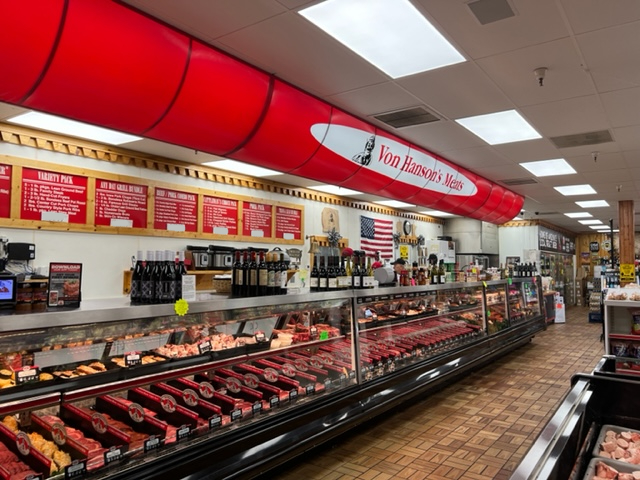Discover the Local Flavor at Bagley Farms Meat Market Edwardsville IL: Fresh and Delicious
Discover the Local Flavor at Bagley Farms Meat Market Edwardsville IL: Fresh and Delicious
Blog Article
Discover the Art of the Butcher's Cut in a Modern Meat Market
In the ever-evolving landscape of contemporary meat markets, the butcher's cut has transcended its typical roots, merging old-time workmanship with modern methods. Today's butchers are not simply processors of meat; they are knowledgeable artisans that highlight sustainability and honest sourcing. Their knowledge in selecting and preparing cuts tailored to details cooking needs provides an unparalleled eating experience. Yet, what really establishes the modern butcher apart is their capacity to create a much deeper link in between consumers and the origins of their meat. Exactly how do these masters equilibrium custom with development, and what effects does this have for the future of meat consumption?
Development of Butchery Methods
The advancement of butchery techniques mirrors an abundant tapestry of advancement and adjustment driven by improvements in innovation, changes in customer demand, and a much deeper understanding of meat science. Historically, butchery was a craft passed down via generations, with techniques sharpened over centuries to maximize return and flavor. The industrial transformation ushered in automation, changing standard techniques and enabling large handling.
The mid-20th century saw butchery techniques additionally fine-tuned by clinical understandings right into muscle mass biology and meat aging, enhancing both inflammation and preference. Advancements like vacuum cleaner packaging and refrigeration extended product shelf-life, permitting butchers to expand offerings and boost high quality control. This duration additionally marked the rise of specific equipment, such as band saws and meat slicers, which increased precision and efficiency in meat handling.

Computerized systems currently aid in tracking pet provenance and optimizing cuts to fulfill particular consumer preferences. Additionally, a renewal in artisanal butchery has arised, mixing traditional skills with contemporary expertise to provide to customers seeking moral and lasting meat choices.
Comprehending Meat Cuts
Recognizing the complexities of meat cuts is vital for both butchers and customers looking for high quality and worth. For butchers, specific cuts reflect skill and regard for the craft, ensuring marginal waste and ideal return.

Understanding muscle mass structure is vital; muscles made use of extra frequently by the animal tend to be tougher and are best fit for slow food preparation approaches, while less-used muscle mass, like those located in the loin, are more tender and ideal for grilling or roasting. Knowledge with these distinctions encourages consumers to make enlightened options, boosting their culinary endeavors.
Choosing Top Quality Meat
Selecting the right meat involves more than simply choosing an aesthetically attractive piece from the display. bagley farms meat market edwardsville il. The art of choosing quality meat calls for a critical eye and expertise of details characteristics that represent freshness and quality. First of all, focus on the color; beef ought to have an intense, cherry-red color, while lamb ought to exhibit a soft pink tone, and pork a light pink. This indicates the meat is fresh and hasn't been revealed to oxygen for too lengthy.
Secondly, consider the marbling, find out this here which describes the white streaks of fat within the muscular tissue. Proper marbling is a vital indication of tenderness and flavor, as it thaws throughout food preparation, boosting the meat's juiciness. Bear in mind, higher marbling often correlates with premium quality cuts, such as USDA Prime.
Texture is an additional critical variable; meat needs to really feel solid to the touch, not slimy or excessively soft. Additionally, bear in mind the aroma. Fresh meat should have a clean, neutral smell, devoid of any kind of sour or repulsive smells.
Matching Cuts With Cooking Techniques

On the other hand, harder cuts like brisket and chuck roast are abundant in collagen, which breaks down right into jelly when prepared gradually. These cuts are optimal for braising or sluggish roasting, permitting the meat to tenderize with time and establish deep, complicated flavors. Cuts such as short ribs and pork shoulder get on well with slow-cooking approaches, where extended cooking times change their robust appearances into succulent meals.
Lamb shanks and oxtail, which call for prolonged food preparation to tenderize, are best prospects for cooking or slow-moving simmering. These methods coax More Info out rich, passionate flavors while maintaining wetness. By comprehending the unique features of each cut, cooks and home cooks alike can raise their cooking productions, guaranteeing each meal is both pleasing and memorable.
The Butcher's Duty Today
Browsing the evolving landscape of the contemporary meat market, the butcher's role today prolongs past mere prep work of cuts. Contemporary butchers are culinary craftsmens, educators, and supporters for sustainable practices.
Along with crafting precise cuts, butchers now engage directly with clients, supplying cooking guidance and tailoring choices to match specific demands and preferences. Their know-how in meat aging, marbling, and taste accounts equips consumers to make enlightened choices, boosting their culinary experiences. This individualized service exhibits the butcher's advancing role as a relied on expert in the kitchen.
Furthermore, butchers are pivotal in lessening waste, making use of whole animals to create diverse items such as sausages and stocks. This extensive method not only respects the pet but also lines up with modern sustainability objectives. In this means, click here for more info the modern butcher personifies both tradition and development, adjusting to an ever-changing market while maintaining the virtuosity and honesty of their craft.
Verdict
Proficiency in understanding diverse meat cuts and top quality signs empowers butchers to supply educated recommendations, aligning certain cuts with optimum food preparation approaches. By recognizing historic methods while accepting contemporary needs, the butcher's role remains crucial in today's sophisticated meat market.
Report this page